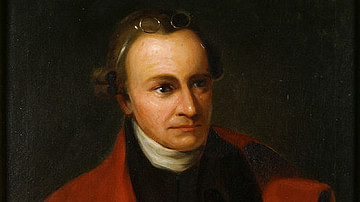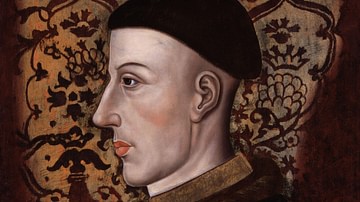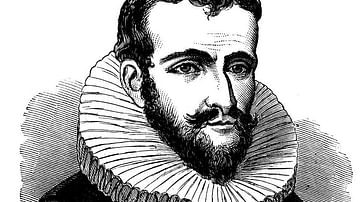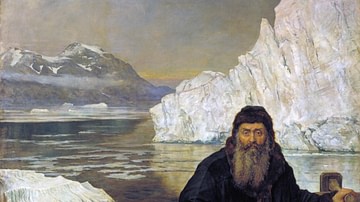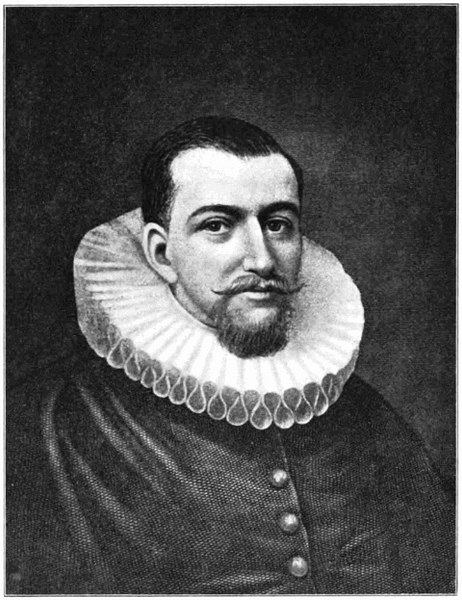
Henry Hudson (c. 1570-1611) was an English navigator and maritime explorer. He is known for his four voyages between 1607 and 1610 in search of a northwest passage via the Arctic Ocean to the Far East. The lure of a northwest passage became an obsession during the 16th century because it would bypass the Spanish and Portuguese-controlled southern waters.
A sea route to the north of Arctic Russia or Canada would help the English to establish themselves in the lucrative silk and spice trade. A polar route was thought to be the most direct, and Peter Plancius (1552-1662), a Dutch cartographer who would later work with Hudson, suggested there was a warm, ice-free polar climate because:
near the Pole, the sun shines five months continually; and although his rays are weak, yet on account of the long time they continue, they have sufficient strength to warm the ground, to render it temperate, to accommodate it for the habitation of men ...
(quoted in Johnson, 20).
This belief fuelled failed attempts to find the fabled Northwest Passage that started with Elizabethan adventurer Martin Frobisher's (c. 1535-1594) 1576 voyage, during which he reached Labrador (east coast Canada) and Baffin Island (between Greenland and the Canadian mainland).
England persisted in sending explorers to the icy expanses of the Arctic, with Captain James Cook (1728-1779) being dispatched in 1776 and Sir John Franklin's (1786-1847) ill-fated expedition bringing to a close the British Admiralty's attempts to find a shorter route between the Atlantic and Pacific Oceans.
Henry Hudson's name was included on the long list of mariners who failed to find the Northwest Passage, but he discovered the Hudson River, Hudson Bay, and Hudson Strait, charted the Arctic region, which laid the groundwork for 18th- and 19th-century polar expeditions, and his explorations of the Hudson River led to the Dutch settlement of New York.
Early Life
Very little is known of Henry Hudson's early years. He was most likely born in the town of Hoddesdon in Hertfordshire, northwest of London, during the reign of Queen Elizabeth I of England (r. 1558-1603). His parents' names are not known, but scholars believe his father was a sea merchant and an alderman of London, and his grandfather (also named Henry Hudson) was one of the founders of the Muscovy Company (an English trading company formed in 1555).
Given his grandfather's connections, Henry Hudson may have gone to sea as a cabin boy and later worked in the company's London office. It has been suggested he was a crew member under Captain John Davis (c. 1550-1605), an English seaman and one of Queen Elizabeth's chief navigators, who searched for the Northwest Passage between 1585 and 1588. Hudson was also a friend of Captain John Smith (1580-1631), one of the founders of the English settlement at the Jamestown Colony of Virginia. By the time Hudson entered the historical record in 1607 in his mid-thirties, he had considerable skill as a navigator and years of seagoing experience, particularly in the Arctic region.
In the early 1590s, Hudson married a woman named Katherine, with whom he had three sons, Oliver, John, and Richard, and they lived in London's St. Katherine's district. John would accompany his father on all four voyages.
No contemporary portrait of Henry Hudson is known to exist, although one was painted of him in 1620 by the Flemish artist Paul van Somer (1577-1621). Sketches and oil paintings depicting Hudson in a canoe on its way to shore to be greeted by indigenous peoples or cast adrift by a mutinous crew are a product of artistic imagination. What is known of Henry Hudson comes from official correspondence, ship logs from his four voyages, and a book called Purchas His Pilgrimes, published in 1625. The Reverend Samuel Purchas (c. 1577-1626) compiled contracts, letters, and records of important navigators, including Henry Hudson.
The First Voyage
Henry Hudson was 37 years old in 1607 when the Muscovy Company commissioned him to sail through Arctic waters on a quest for a route over the North Pole to the Far East. The Reverend Richard Hakluyt (1553-1616), a noted geographer who sat on the company's board, recommended Hudson. It was the first of four voyages, and Hudson left Gravesend, England, on 1 May 1607. His ship, a 40-ton barque, was named the Hopewell, and it had twelve crew, including Hudson's young son John.
The Shetland Islands (north of Scotland) were sighted on 26 May, and by 13 June, the Hopewell had neared the east coast of Greenland. On 22 June, the Hopewell lay off a peninsula, which Hudson named Hold-with-Hope, a name still in use and one of the oldest geographical names in eastern Greenland.
Hudson held to Plancius' theory of warm waters in the Arctic region, but his ship encountered stormy seas, and ice impeded the journey north. Whales and grampuses (members of the dolphin family) surrounded the ship as it made its way to Spitsbergen, the largest island in the Svalbard archipelago, where it arrived on 29 July. Hudson and his crew came within 928 kilometres (577 mi) of the North Pole but were forced to turn back due to the dangers posed by icebergs. No European explorer had reached such high latitudes before.
Henry Hudson returned to Tilbury, England, opposite Gravesend, on September 15, 1607, having veered 800 kilometres (497 mi) off course, presumably in a determined search for a northwest passage. As the Hopewell headed south, Hudson discovered Hudson's Tutches (Jan Mayen Island) north of Iceland.
Although he failed to find a shorter route to the Far East during the three-and-a-half-month journey, Hudson's exploration around Spitsbergen and his sighting of an abundance of whales in the bays of the Svalbard archipelago set in motion the lucrative whaling industry. Some of his crew killed a polar bear on Spitsbergen and fell ill after consuming the toxic, vitamin A-rich liver. The Muscovy Company also benefited from Hudson's reports of walrus at Hudson's Tutches, with thousands being killed for their tusks.
Henry Hudson's first voyage mapped parts of an uncharted Arctic region, but the arduous, bone-chilling journey also highlighted Hudson's lack of leadership skills – a problem that would later prove fatal. Hudson's first mate was William Collins, with whom Hudson clashed and demoted to bosun, replacing Collins with the less experienced John Colman. Hudson's actions caused discontent among the crew, a crew already troubled by what they considered the 'evil spell' cast by the erratic behaviour of Hudson's compass at magnetic north.
The Second Voyage
Back in England, Hudson spent time with Richard Hakluyt, who showed him charts and the route taken by the Dutch navigator, Willem Barentsz (1550-1597), who had sailed from Amsterdam in 1594 in search of a northeast passage to Cathay (China) that was believed to exist north of Russia. The Muscovy Company commissioned Hudson again in 1608 to follow a sea route past the northern end of Novaya Zemlya, Russia, where Barentsz had explored. This would lead to the Kara Sea, and Hudson intended to then sail east along the Siberian coast until he reached the passage leading to the Pacific Ocean. However, no explorers had been so far north, so maps and charts contained incorrect latitudes and longitudes. Hudson set sail again in the Hopewell in April 1608 with a 1594 Peter Plancius map based on a 1569 Mercator map. Both maps showed possible (but incorrect) northeast passages.
Hudson sailed with a 15-strong crew, including his son John and Robert Juet (1578-1611). Only three men from Hudson's first crew signed on for this second voyage. Juet was an older English seaman who would sail with Hudson on further voyages, and he kept an extensive journal of the voyage. Hudson's own notes would later be published in Purchas His Pilgrimes. The Hopewell was reinforced with planking to protect against sea ice.

By May 1608, Hudson had reached the northern tip of Norway, and in late June, Novaya Zemlya was sighted. The voyage was not without incident. The Hopewell floundered on ice, and the crew finally broke the ship free after four hours. Hudson's log for 15 June 1608, recorded a mermaid swimming alongside the ship (most likely a seal).
Hudson attempted to sail north, but thick sheets of ice proved that a northeast passage to Cathay was not possible, so the ship was turned around. Having failed to find a northeast passage for the Muscovy Company, Hudson did two things: hunted walruses for their tusks and blubber and subtly changed the southward heading course so the Hopewell headed west. The first action would be profitable for the Muscovy Company, for its board would not be pleased that their navigator had not fulfilled the expedition instructions. The second action stemmed from Hudson's determination to find a northwest passage, and when the crew, led by Robert Juet, realised that England was not their destination, a mutiny loomed. Hudson bowed to pressure, and the Hopewell arrived at Gravesend on 26 August 1608. Each crew member was given a certificate of release before stepping ashore. Mutineers could be hanged, and the certificate's wording exonerated the Hopewell crew.
Hudson's partnership with the Muscovy Company ended as the board was unwilling to fund further expeditions, and their interest in finding a northeast passage faded.
The Third Voyage: Captain-for-Hire or English Spy?
In November 1608, Henry Hudson received a letter from the Verenigde Oostindische Compagnie (VOC), or Dutch East India Company. The Dutch controlled the Indian Ocean trade, but their ships had lengthy voyages around the Cape of Good Hope or through the Strait of Magellan (the southern tip of South America). Like the English, the VOC wanted to find a shorter route and invited Hudson to Amsterdam. However, Hudson's extensive knowledge of the Arctic region and his fame did not convince all 17 board members, and there were no plans to sponsor an expedition.
While in Amsterdam, Hudson met with Peter Plancius, drawing maps of his two voyages and trying to convince him that a northwest passage existed north of 60º N latitude (Plancius favoured a northeast passage). The VOC then caught wind that Hudson was negotiating secretly with Henry IV of France (1553-1610) and promptly offered him a contract that was signed in January 1609. The contract stipulated that Hudson would search for a northeast passage to the north or northeast of Novaya Zemlya and on towards India. It further stipulated that he was not to search for another route. Presumably, the Dutch had learned of Hudson's habit of disobeying instructions during his second voyage when he headed west in the Hopewell rather than return immediately to England.

Hudson was not the first captain to sail under a foreign flag. Sebastian Cabot (1474-1557), a Venetian navigator, sailed for England, and Giovanni da Verrazano (1485-1528) was an Italian in French service.
The Dutch provided Hudson with the three-masted square-rigged vessel Halve Maen (the Half Moon), an old and incredibly small ship that was 25 metres (84 ft) long and 5.1 metres (17 ft) wide. Hudson signed up a crew of 20 (although some records say 16), which again included his son John and John Colman as second mate. Robert Juet, a man said to be of foul temperament, stirred up tension between the English and Dutch crew as they proceeded north in April 1609, following the Norwegian coastline. Rough weather and gale-force winds perhaps contributed to what happened next: Hudson ignored the VOC's instructions to search for an easterly route to the Far East and sailed west across the Atlantic to America, the New World, believing it would provide a shorter route. Hudson's friend, Captain John Smith, spent over three months exploring Chesapeake Bay, looking for a northwest passage to the Pacific, and correspondence between the two friends may have convinced Hudson that success lay in North America. He had maps of the New World on board the Halve Maen. The crew was also fed up with the fierce storms and cold weather, so perhaps Hudson promised them a warmer climate so he would not be faced with a ship full of mutineers.
The Halve Maen landed in Newfoundland, Canada, before heading south and exploring Penobscot Bay (southern Maine), Cape Cod, Chesapeake Bay, and Delaware Bay, entering New York harbour on 3 September 1609 at the mouth of the wide river that now bears Hudson's name. He then explored the coast of present-day New Jersey and anchored off Manhattan Island, welcoming indigenous people on board to exchange furs and tobacco.
On 4 October, Henry Hudson decided to return not to Holland but to Dartmouth, England, where King James I of England (1566-1625) was unwilling to allow Hudson to comply with the VOC's demands that he and the crew return to Holland. Dutch historian Hessel Gerritz (1581-1632) suggested that the real reason for Hudson's arrival in England was to report to his true employers and that he purposely headed to the New World rather than find a shorter sea route to the Far East that would benefit his country's rivals. Hudson's logs were eventually returned to Holland, and the Halve Maen sailed home in July 1610.
The Fourth & Final Voyage
The Company of Gentlemen Adventurers, an independent group of investors that included diplomat Sir Dudley Digges (1583-1639) and merchant Sir Thomas Smythe (1558-1625), backed Hudson for his fourth voyage in April 1610 with a crew of 21, including John Hudson and Robert Juet. The Discovery was a 19.8-metre (65 ft) barque that set sail from St. Katherine's Dock, London, bound for Greenland.
Knowledge gained from the three previous voyages had convinced Hudson that the Northwest Passage would be found north of 60º N latitude, and the Discovery entered James Bay at the southern end of Hudson Bay, Canada. When Hudson left England, there had been enough food for eight months, but supplies had dwindled, and there were accusations of food hoarding levelled at the captain.
The Discovery explored James Bay, and an interesting theory was proposed in the Beaver Magazine in September 1999 by Carl Schuster (writer and explorer). Schuster suggested that Hudson systematically searched James Bay, covering 25-kilometre (16 mi) swaths with each pass and that he was not looking for a northwest passage but copper, gold, or silver – mineral wealth that Hudson Bay had in abundance. Given the wealthy merchants that constituted The Company of Gentlemen Adventurers, all of whom had close ties to the crown and a monarch who was heavily in debt, this theory may explain why Hudson chose to remain in James Bay rather than head further northwest where the fabled passage to the Far East was thought to lie.

When spring arrived in 1611 and Hudson decided to continue the exploration of James Bay, the crew, led by Robert Juet, mutinied. With only 14 days of food left, Captain Henry Hudson, his son John, and seven loyal crew were cast adrift on June 23 in a shallop (small boat with oars and sail), never to be seen again. Juet took command, and the Discovery sailed for England, docking in London with only eight crew, who were tried in the High Court of Admiralty. Juet died on the home voyage, and his body was committed to the sea off Ireland.
Was it a murderous mutiny? Blood stains were found on the ship, as well as letters suggesting a conflict between Hudson and his crew. Some of Hudson's possessions were also missing. Was he murdered and his body cast overboard? There is also the possibility that Henry Hudson survived. In 1959, a construction worker near Chalk River (around 1.5 hours from James Bay) discovered "HH 1612 CAPTIVE" etched on a rock surface – do the initials HH stand for Henry Hudson?
The shallop was 75 kilometres (46 mi) from shore, and it is possible Hudson and his crew made it to land only to be captured by the Algonquin people who inhabited the area. French explorer Samuel De Champlain (1567-1635), who was travelling up the Ottawa River in 1613, heard rumours that the Algonquin had captured an English youth (possibly Hudson's teenage son).
The disappearance of Henry Hudson remains one of history's most intriguing mysteries.
Hudson's Achievements
Henry Hudson's name has perhaps been remembered more than his achievements. After his presumed death in 1611, it was two centuries before his voyages were given recognition by the New York Historical Society in 1809, which commemorated Hudson's discovery of New York and his four voyages.
Hudson's key contributions were:
- The discovery of the Hudson River, Hudson Bay, and Hudson Strait
- Furthering knowledge of the Arctic's maritime geography
- Expanding Dutch influence and paving the way for the establishment of New Amsterdam (later New York)
- Contributing to the cartographic knowledge of the New World






